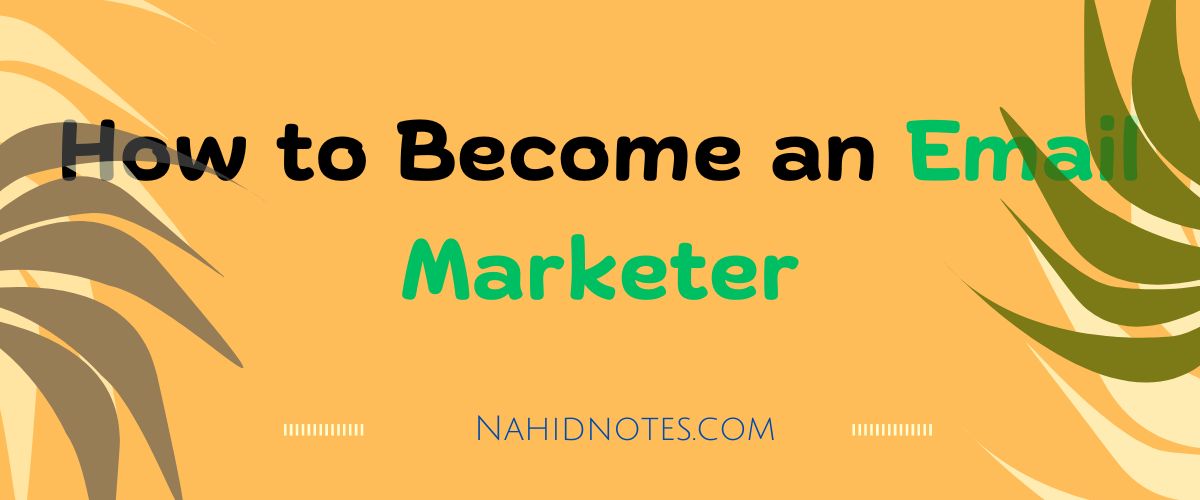To become an email marketer, acquire digital marketing skills and gain experience with email marketing tools. Familiarize yourself with email automation, segmentation, and analytics.
Email marketing is a popular and effective digital marketing strategy that allows businesses to connect with their audience directly. As an email marketer, you can create, analyze, and optimize email campaigns to drive engagement and conversions.
You can excel in this dynamic and rewarding field with the right skills and knowledge.
In this blog, we will explore the steps to becoming an email marketer, the essential skills required, and the potential career opportunities in the ever-evolving digital marketing landscape.
Whether you're a marketing enthusiast or looking to switch careers, mastering email marketing can open up new and exciting possibilities for you.

Credit: m.economictimes.com
The Rise of Email Marketing
Email marketing has experienced a meteoric rise in recent years, becoming a pivotal tool for businesses to engage with their audience and drive conversions. As technology continues to advance, the effectiveness and reach of email marketing have only grown stronger, making it a top choice for marketers aiming to build lasting connections with their customer base.
Why Email Marketing Thrives
Email marketing thrives due to its unmatched ability to deliver personalized, targeted content directly to the inbox of potential customers. With high open and click-through rates, email marketing remains a cost-effective and efficient way to reach and engage with a large audience.
Comparing Channels: Email Vs. Social Media
When comparing email marketing to social media, it's clear that email holds a unique advantage. Unlike social media, where content quickly gets buried in a fast-moving feed, emails have a longer lifespan and can be easily referenced by the recipient at any time. Additionally, email marketing allows for more direct, personalized communication with the audience, leading to higher conversion rates and stronger relationships.

Credit: emeritus.org
The basic principles of email marketing are essential for anyone looking to become an email marketer. Understanding these principles lays the foundation for successful email campaigns that engage and convert. Let's delve into these fundamental aspects that form the cornerstone of effective email marketing strategies.
The Power Of Personalization
Email personalization involves tailoring your messages to specific individuals or groups. Personalized emails have higher open and click-through rates, leading to increased conversions. Personalization can include using the recipient's name, segmenting your email list based on demographics or behavior, and providing customized content based on past interactions.
Crafting Compelling Subject Lines
The subject line is the first thing recipients see, making it crucial for grabbing their attention. Compelling subject lines are concise, clear, and evoke curiosity. Using action verbs, posing questions, and creating a sense of urgency can encourage recipients to open the email. A/B testing subject lines can help determine which ones resonate best with your audience.
Setting the Stage: Tools and Platforms
To excel as an email marketer, you need to master the essential tools and platforms. By familiarizing yourself with email marketing software like Mailchimp and platforms such as Google Analytics, you can create, analyze, and optimize your campaigns effectively.
Understanding these tools is crucial for achieving success in email marketing.
Email marketing is an essential component of any successful digital marketing strategy. But to become a proficient email marketer, you must choose the right tools and platforms that can help you streamline your campaigns and achieve your goals.Choosing the Right Email Marketing Platform
Choosing the right email marketing platform can make or break your email campaigns. With so many options available in the market, it can be overwhelming to select the right one. However, here are some factors to consider before selecting a platform:- Features: Look for platforms that offer features such as automation, list segmentation, A/B testing, and customizable templates.
- Cost: Consider the platform’s pricing structure, which can be based on the number of subscribers or emails sent.
- User-friendliness: Choose a platform that is easy to navigate and use, even for beginners.
- Integration: Ensure the platform integrates with other tools and applications you use.
- Support: Look for a platform that offers reliable customer support.
Integrating Analytics for Insight
Integrating analytics into your email marketing strategy can provide valuable insights into your campaigns' performance. Here are some ways to integrate analytics:- Track email opens and clicks: Use tracking pixels to track how many subscribers open your emails and click on the links.
- Integrate with Google Analytics: By integrating your email platform with Google Analytics, you can track website traffic generated by your email campaigns.
- Segment your data: Segment your email list based on specific criteria to get a better understanding of your subscribers and tailor your campaigns accordingly.
- Track conversions: Use conversion tracking to measure how many subscribers complete a desired action, such as making a purchase or filling out a form.
Lead Magnets: The Enticers
One of the most effective ways to build your email list is by offering lead magnets. Lead magnets are valuable incentives that entice visitors to sign up for your email list. These can be in the form of ebooks, whitepapers, checklists, or any other valuable content that your target audience would find useful. By providing these lead magnets, you not only capture their attention but also establish yourself as an expert in your industry.
Optimizing Sign-up Forms
Optimizing your sign-up forms is crucial to ensure a high conversion rate. Here are some key tips to consider:
- Keep it simple and concise: Make sure your sign-up form is easy to understand and fill out. Avoid asking for too much information, as this can deter potential subscribers.
- Place it strategically: Position your sign-up form in a prominent location on your website, such as the homepage or sidebar. This way, visitors won't miss it and are more likely to subscribe.
- Create compelling copy: Use persuasive language and highlight the benefits of joining your email list. Let your audience know what they will gain by subscribing.
- Offer incentives: Consider offering additional incentives, such as exclusive discounts or access to premium content, to encourage sign-ups.
- A/B test your forms: Experiment with different variations of your sign-up forms to see which ones yield the highest conversion rates. Test different headlines, button colors, or form placements to optimize your results.
Creating Engaging Content
To excel as an email marketer, focus on creating engaging content that resonates with your audience. Craft compelling subject lines, personalize your messages, and provide valuable, relevant information to build trust and drive engagement.
Use visual elements and clear calls-to-action to encourage interaction and ultimately, conversions.
Creating Engaging Content is a crucial part of being an email marketer. It is the most effective way to capture the attention of your audience and keep them engaged.The Art of Storytelling in Emails
Storytelling is an essential part of human communication. It is a powerful tool that can be used to create emotional connections with your audience. When telling a story in an email, it is important to have a clear beginning, middle, and end.Visuals and Ctas: Grabbing Attention
Visuals are an effective way to grab the attention of your audience. They can also help to break up long blocks of text and make your email more visually appealing. Use high-quality images and graphics that are relevant to your message.
Credit: www.indeed.com
Segmentation and Personalization Strategies
Segmentation and personalization strategies are essential for becoming a successful email marketer. By understanding your audience and tailoring your messages to their specific needs and interests, you can build stronger relationships and achieve higher engagement rates.
With careful planning and implementation, you can elevate your email marketing game and drive better results for your business.
Segmentation and personalization are two of the most critical strategies when it comes to email marketing.Tailoring Messages for Your Audience
To tailor your messages for your audience, you need to understand their preferences, interests, and behaviors. One way to do this is by segmenting your email list based on various criteria, such as demographics, past purchase history, or engagement levels.Behavior-based Email Automation
Behavior-based email automation involves sending automated emails triggered by a specific action or behavior, such as abandoning a cart or signing up for a newsletter. These automated emails can be highly targeted and personalized, based on the recipient's behavior.Testing and Optimization
Testing and optimization are crucial aspects of becoming a successful email marketer. By constantly analyzing and refining your email campaigns, you can improve their effectiveness, and engagement, and ultimately, achieve better results.
There are two key areas to focus on when it comes to testing and optimization: A/B testing your emails and analyzing data for continuous improvement.
A/b Testing Your Emails
A/B testing involves creating two versions of an email and testing them against each other to determine which version performs better.
This method allows you to experiment with different elements, such as subject lines, call-to-action buttons, or even the overall layout, to see which variation resonates more with your audience.
When conducting A/B tests, it's important to focus on one variable at a time to accurately measure its impact. For example, you can test two different subject lines to see which one generates higher open rates.
By analyzing the results, you can gain insights into what works best for your specific audience and optimize your future campaigns accordingly.
Analyzing Data for Continuous Improvement
Analyzing data is essential for identifying trends, patterns, and areas of improvement in your email marketing efforts. By tracking key metrics such as open rates, click-through rates, conversion rates, and subscriber engagement, you can gain valuable insights into the performance of your campaigns.
Start by analyzing the data from your A/B tests to understand which elements are driving better results. Look for patterns and trends that emerge from the data to inform your optimization strategies. For example, if you consistently see higher click-through rates for emails with personalized content, you can prioritize personalization in your future campaigns.
Additionally, segmenting your email list based on demographics, preferences, or past behavior can provide valuable data for tailoring your content and offers to specific segments. This targeted approach can lead to higher engagement and conversion rates.
To effectively analyze your data, it's important to use email marketing software that provides robust reporting and analytics capabilities. These tools can help you track and measure the performance of your campaigns, making it easier to identify areas for improvement and make data-driven decisions.
Remember, testing and optimization are ongoing processes. Continuously analyze your data, experiment with different strategies, and adapt your approach based on the insights you gain. By doing so, you can refine your email marketing efforts and achieve better results over time.
Advanced Email Marketing Tactics
Learn how to become an email marketer with advanced tactics that go beyond the basics. Discover effective strategies for optimizing email campaigns, improving open rates, and increasing conversions. Maximize your skills and take your email marketing efforts to the next level.
Email marketing is an ever-evolving field, and staying up-to-date on the latest techniques and strategies is essential to achieving success. Advanced email marketing tactics, such as leveraging AI for personalization and using predictive analytics in crafting future campaigns, can take your email marketing game to the next level.Leveraging AI for Personalization
Personalization is a key aspect of successful email marketing. By leveraging AI and machine learning, you can create highly personalized campaigns that are tailored to each individual subscriber. This can help to increase open and click-through rates, as well as improve overall engagement.Predictive Analytics in Crafting Future Campaigns
Predictive analytics is another advanced email marketing tactic that can help you craft more effective campaigns in the future. By analyzing past campaign data and using predictive modeling, you can predict which campaigns will be most successful in the future.Frequently Asked Questions
What Do You Need to Be an Email Marketer?
To be an email marketer, you need strong communication skills, knowledge of email platforms, an understanding of customer behavior, creativity, and analytical abilities.
How to Start a Career in Email Marketing?
To start a career in email marketing, gain knowledge in digital marketing and email platforms. Create and optimize email campaigns, build a portfolio, and pursue relevant certifications. Network with industry professionals and seek internships or entry-level positions to gain practical experience.
How Long Does It Take to Become an Email Marketer?
Becoming an email marketer typically takes a few months to a year. It involves learning email marketing strategies, building a subscriber list, creating engaging content, and analyzing campaign performance. With dedication and practice, you can become an email marketer in a relatively short period.
How Much Do Email Marketers Make?
Email marketers can earn a competitive salary based on their experience, skills, and industry. Salaries typically range from $40,000 to $100,000 per year, with opportunities for growth and higher earnings as they advance in their careers.
Conclusion
Becoming an email marketer requires a strategic approach and a deep understanding of your target audience. By mastering the art of crafting compelling subject lines, creating engaging content, and utilizing email automation tools, you can effectively connect with your subscribers and drive conversions.
Remember to regularly analyze your email campaigns' performance and make necessary adjustments to optimize your results. With dedication and continuous learning, you can become a successful email marketer and harness the power of this valuable marketing channel.


